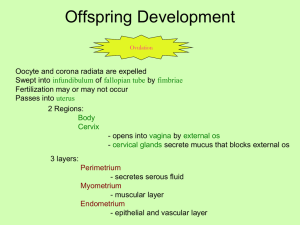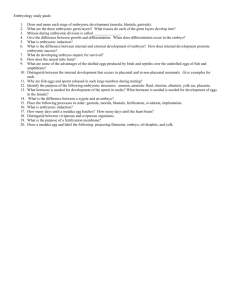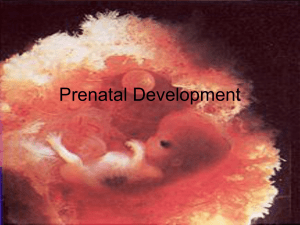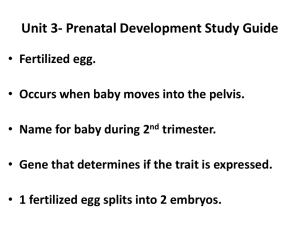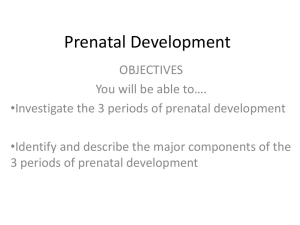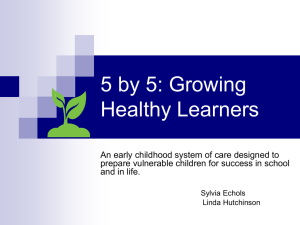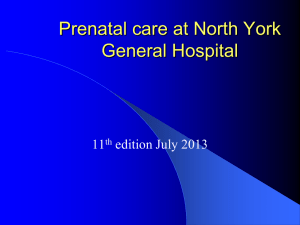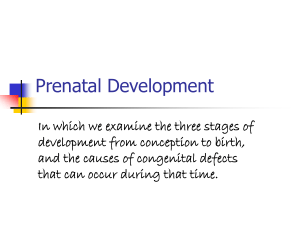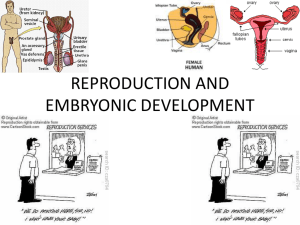Embryonic Growth
advertisement
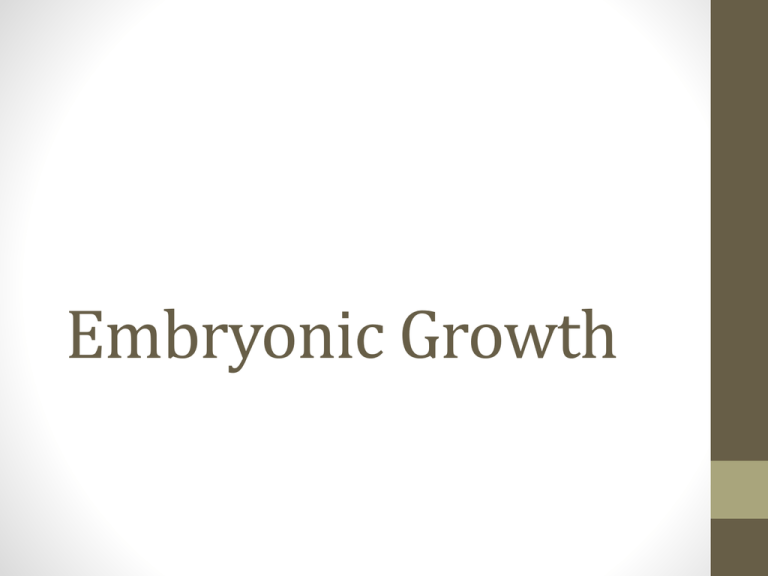
Embryonic Growth Objectives • Explain prenatal development from fertilization to birth • Understand different biological process’ in all phases of prenatal development • Define key vocabulary • Chart different phases in somitogenesis Prenatal Development • A multitude of events need to occur at the appropriate time with little to no errors • Embryonic development Gestation Comparison Prenatal Development • Ovum Phase • Zygote to morula • Embryonic Phase • Blastocyst to fetus • Fetal Phase • Fetus to birth Prenatal Development Ovum Phase • Zygote – Early DNA and protein synthesis • Two-cell stage – Start of M, T, and tRNA synthesis • Morula – Cells are totipotent • Totipotent- ability to become any cell in the entire body • Stem Cells Meiosis • Formation of gametes • Contain half of the information that you need for reproduction • Formation of four 1N daughter cells • 1N indicates that half of the necessary information is present • Provides variation in sexually reproducing animals Zygote • Fertilized egg • Unfertilized egg from mother • Sperm from father Cell Cleavage • There is an increase in DNA, but cells are not getting larger • Simply making more DNA Cell Cleavage • Morula composed of 20-30 cells • Hatching – As the cell nears implantation the zona pellucida begins to break down • Blastomeres have great developmental plasticity Ovum Phase • Cells maintain totipotency • If some cells of the blastomere are damaged it can still undergo normal development. • Embryo splitting can be performed at this stage • Identical twins • Characterized by cellular replication • No protein synthesis • Little to no increase in size of organism Implantation Embryonic Phase • Characterized by morphogenesis • Creation of shape • Single layer of cells giving rise to multiple cell layers • Blastulation • Rapid increase in blastomere (embryonic cell) number • Formation of a flat layer of cells (trophoblasts) that surround the blastocoele (fluid filled cavity) Embryonic Growth • Blastulation • Rapid increase in blastomere (embryonic cell) number • Formation of a flat layer of cells that surround the fluid filled cavity • This is how the placenta is formed. • Embryonic Development Blastocyst • Inner Cell Mass (ICM) • Destined to become the embryo • Trophoblast • Flattened layer of cells destined to become the placenta Embryonic phase • • • • Begins with blastocyst formation Implantation into the uterine wall occurs Cells lose totipotency Characterized by tissue differentiation Germ Layers • Ectoderm • Skin and neural tissue • Mesoderm • Muscle, bone, and dermis tissue • Endoderm • Respiratory and gastrointestinal tracts Neuralation • Form the precursors of the spinal cord and column • Neural tube • Precursor to the spinal cord and central nervous system • Notochord • Precursor to the spinal column Somitogenesis • Develop from cranial to caudal • Three cell areas • Sclerotome • Myotome • Dermatome Somitogenesis • Sclerotome • Bone formation • Myotome • Muscle formation • Dermatome • Dermis formation Limb Bud Formation • Limb bud somites- located in a spot where you find a limb Fetal Phase • Most tissues are already formed • Characterized by a dramatic increase in size of existing organs and tissues. Measurements of Prenatal Development • • • • Somite Formation Weight Length Anatomical changes • Hair • Eyelids Objectives • Explain prenatal development from fertilization to birth • Understand different biological process’ in all phases of prenatal development • Define key vocabulary • Chart different phases in somitogenesis
